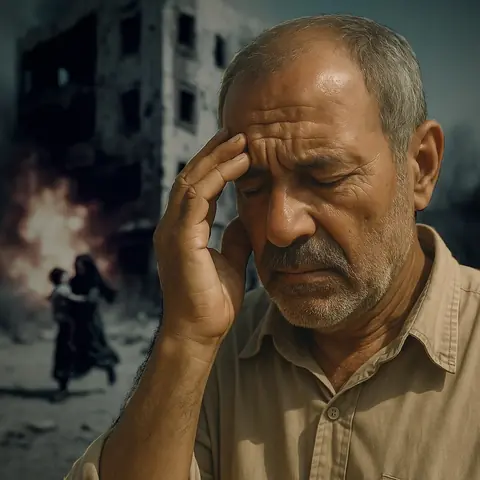I would like to share with you a strange real-life experience told to me by my close friend and trusted colleague, Khaled, a 50-year-old man whom I consider a brother.
Khaled owns an apartment on the second floor of a four-story residential building in the southern suburbs of Tripoli, Libya - a region that had been heavily affected by armed clashes between militias.
After fierce battles devastated the area, destroying roads, utilities, and homes, most residents fled. For about four months, Khaled’s neighborhood was almost completely abandoned. His apartment survived with minor damage but had suffered a fire caused by shell fragments.
Determined to rebuild, Khaled hired several Egyptian workers: a plumber, an electrician, and three painters. Due to the fragile security situation, Khaled personally transported them each day from central Tripoli to the damaged zone.
Later, the workers requested permission to sleep overnight inside the apartment to work faster, and Khaled agreed under the condition that he would bring them food and water daily.
One morning, the plumber went up to the rooftop to install a ventilation pipe. There, he was startled to see a woman hanging laundry on a clothesline - something unexpected in what they thought was a deserted building. Embarrassed, he quickly retreated without finishing his task.
When he shared this encounter, Khaled was skeptical. Together, they searched the building but found no woman, no clothesline, no signs of life.
Brushing it off as a misunderstanding, they returned to work.
Two days later, as the workers were preparing to sleep around 10:30 PM, the unimaginable happened:
Suddenly, the silence exploded into the sounds of violent gunfire, heavy artillery, screams of women and children, and sirens—as if the war had returned.
Panicking, the workers crawled to shelter, peeking outside through the windows. But despite the vivid sounds, they saw nothing: no explosions, no flashes, no vehicles, no people.
The chaos lasted for about five minutes, then abruptly faded, plunging the area back into total, eerie silence.
They immediately called Khaled, begging him to evacuate them.
The next day, Khaled investigated: there had been no clashes reported in the area. Even the security units confirmed that the region remained deserted and calm.
Trying to reassure them, Khaled decided to stay with the workers that day.
At around 3 PM, as Khaled returned from his car with a pack of cigarettes, he came face to face with a woman descending the stairs—matching exactly the description given by the worker earlier: same features, same clothing.
The woman passed him silently, without any acknowledgment.
Terrified, Khaled rushed upstairs and organized a thorough search of the building. Once again, they found no trace: no footsteps, no physical evidence.
Khaled then ordered the suspension of all renovation work until residents returned to the neighborhood.
- This account was personally told by Khaled to Saeed Abdullah, a 60-year-old Libyan citizen, who shared it with me in vivid detail.
Told By Saeed Abdullah
Possible Explanations
A) Paranormal Interpretations
In Islamic and Arab folklore, experiences like these are categorized under "Ghosts of War" or "Specters of Tragedy."
It is believed that souls of those who die violently or suddenly—especially in wars—may remain "stuck" in the places where they perished, unable to move on due to the trauma, injustice, or lack of proper funeral rites.
These residual hauntings often replay the events of death, creating eerie loops of sound or apparition, particularly in places recently devastated by conflict.
The "battle sounds" heard by the workers - with no physical war happening outside - resemble what paranormal researchers call residual energy phenomena, where buildings or landscapes seem to "record" traumatic events and replay them under certain conditions (especially at night, in silence, or when strangers first disturb the area).
The mysterious woman seen on the rooftop and later on the stairs may represent a spiritual manifestation - a lost soul trapped in a cycle of her last actions (e.g., hanging laundry) before death.
Similar phenomena have been reported in post-conflict zones worldwide: Gaza, Syria, Iraq, Rwanda, Bosnia, and even Europe after World War II.
While skeptics may attribute such incidents to imagination or stress, the recurrence of similar reports across different cultures suggests that there may be more to these stories than mere coincidence.
B) Psychological and Behavioral Explanations
Alternatively, several scientific theories could explain the incident:
Mass Hysteria (Mass Psychogenic Illness)
Psychological symptoms can spread among groups under extreme stress, particularly in isolated or traumatized environments.
Residual Perception
The brain may "fill in" missing sensory information based on prior traumatic memories, creating hallucinations or sensory misinterpretations.
Post-Traumatic Stress Disorder (PTSD)
Exposure to environments resembling past trauma can trigger flashbacks or acute anxiety episodes, even in people without a formal PTSD diagnosis.
Sensory Deprivation
Long exposure to silence and isolation can cause the brain to manufacture sensory experiences such as hearing nonexistent sounds or seeing illusory figures.
The "Genius Loci" Hypothesis
Some anthropologists suggest that locations saturated with intense human emotion especially death and suffering—develop a "psychological atmosphere" that deeply influences visitors, stirring feelings of unease or hallucinations.
#These accounts are published as real experiences according to the testimonies of those who lived them. However, no definitive claims are made about their objective reality.






No comments:
Post a Comment